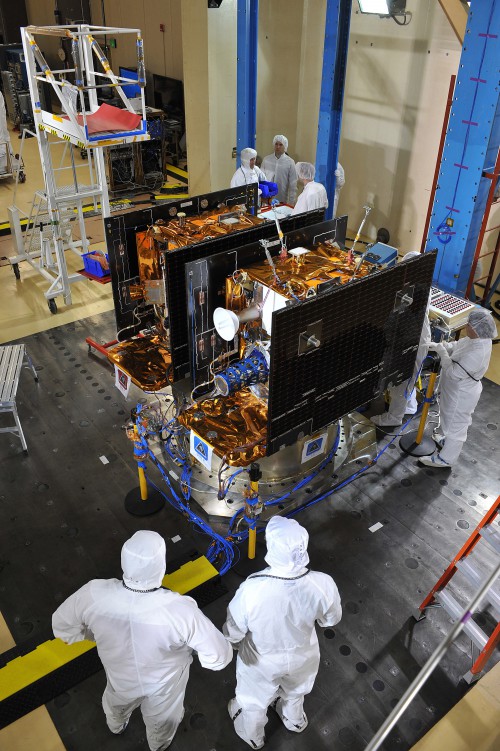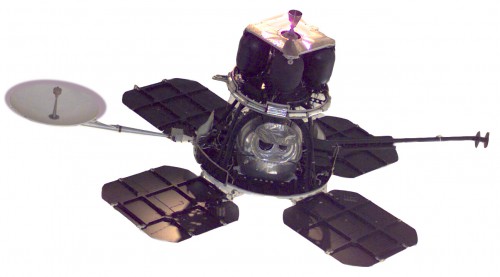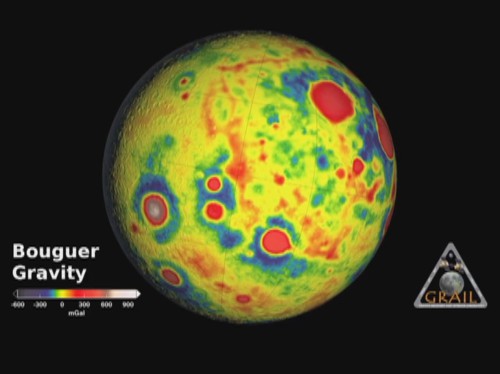
Even though the twin spacecraft Ebb and Flow, part of the Gravity Recovery and Interior Laboratory mission, crashed into the Moon’s surface December 17, 2012, scientists continue to pour over the massive amounts of data they returned.
A team led by Dr. Jay Melosh of the Lunar and Planetary Laboratory of Purdue University has used some of the data to offer a solution to a lunar mystery first uncovered during the preparations for the manned Apollo missions.
After President Kennedy challenged the nation to send a man to the Moon, NASA began a crash program to reconnoiter the Moon in preparation for the landings. The 5 Lunar Orbiter spacecraft were part of that program. The Lunar Orbiters served two purposes: imaging potential landing sites and proving the ability of the Deep Space Network to track the Apollo spacecraft in lunar orbit.
In 1968, after the last Lunar Orbiter had been crashed into the Moon to clear the way for Apollo, two JPL scientists used data gathered from the Deep Space Network as it tracked Lunar Orbiter V to create a gravity map of the Moon’s near side.

A gravity map illustrates the intensity of a body’s gravity field as a function of location over the surface of the body. A body whose mass was distributed perfectly spherically would have a perfectly smooth gravity map. But real planets do not have perfectly spherical mass distributions, so in certain places the intensity of the gravity field is higher than others. Regions where mass is concentrated more densely, like around mountain ranges, have a more intense local gravity field, while other regions have a lower mass density and have a consequently weaker local gravity field.
The two JPL scientists noted that there were several large concentrations of mass under the lunar surface not associated with surface features that would logically cause such concentrations, and dubbed them “mascons.” These mascons seemed to be associated with the great lunar basaltic plains, the maria. The JPL scientists offered no explanation in their paper, Mascons: Lunar Mass Concentrations, published in the 16 August 1968 issue of Science.
The GRAIL mission was launched in September 2011 and began collecting data in March 2012. GRAIL’s goal was to create the most accurate map of the lunar gravity field ever attempted.
The GRAIL mission had two spacecraft, initially referred to as GRAIL-A and GRAIL-B. Shortly after assuming orbit of the Moon they were renamed Ebb and Flow. The two spacecraft flew in formation in an extremely low orbit and carefully measured the distance between them with two-way Ka-band link. As the spacecraft flew over the lunar surface, they were accelerated and decelerated as they passed over regions of the Moon which had stronger and weaker gravity fields. This caused the distance between the spacecraft to change, and this change was carefully measured to micrometer-level accuracy. This allowed scientists to create a lunar gravity map of unprecedented accuracy.
This allowed GRAIL co-investigator Dr. Jay Melosh and a group of other scientists to examine the Moon’s mascons in detail that was totally impossible in 1968.
Dr. Melosh and his team combined the gravity map created by GRAIL with the topographical map created by the Lunar Orbiter Laser Altimeter instrument aboard the Lunar Reconnaissance Orbiter. Using the topographical data, also of unprecedented detail, the team was able to “subtract” out the obvious sources of high local gravity fields, like mountains. This left only the “hidden” sources of high gravity signals—the mascons.

Close examination of the mascons showed they share a similar structure. The center of the mascon exhibits a very high gravity signal—and thus a large concentration of massive material. A ring of low gravity signal surrounds the center, and this low gravity region is surrounded by another ring of high gravity signal. The overall appearance of the structure, in a detailed gravity map, creates the impression of a “bulls-eye” symbol.
Dr. Melosh and his group concluded that the mascons originated in the distant past, when the Moon’s interior retained some of its primordial heat. The group proposed in their paper that a mascon was created when a large impactor slammed into the thin, young lunar crust, carving out a massive crater and melting the rock at the center of the impact. The molten material became concentrated in the center of the crater, resulting in a region of high density. The crater collapses over time, becoming buried in less-dense material. This creates the ring of low gravity signal around the dense core. The outer, more dense ring was created by material ejected from the impact crater.
This theory was developed with the assistance of sophisticated computer simulations that modeled the behaviour of the Moon’s crust and mantle after a massive impact. When the computer model is fed the best-available data and assumptions about the composition of the Moon, and reasonable assumptions about the nature of a hypothetical impactor, the mysterious mascon structures form neatly, and the model’s description of the mascon structure is very consistent with the data obtained by GRAIL.
Dr. Melosh and his group set forth their theory in an article, The Origin of Lunar Mascon Basins, available in the 30 May edition of Science.
Mascons are not only found on the Moon. Similar structures have been detected on Mars and Mercury, and all the terrestrial bodies in the Solar System have been subjected to such massive impacts, including Earth. Dr. Melosh believes that learning about the Moon’s mascons may solve mysteries closer to home, saying, “Our planet suffered similar impacts in its distant past, and understanding mascons may teach us more about the ancient Earth, perhaps about how plate tectonics got started and what created the first ore deposits.”
Want to keep up-to-date with all things space? Be sure to “Like” AmericaSpace on Facebook and follow us on Twitter: @AmericaSpace



